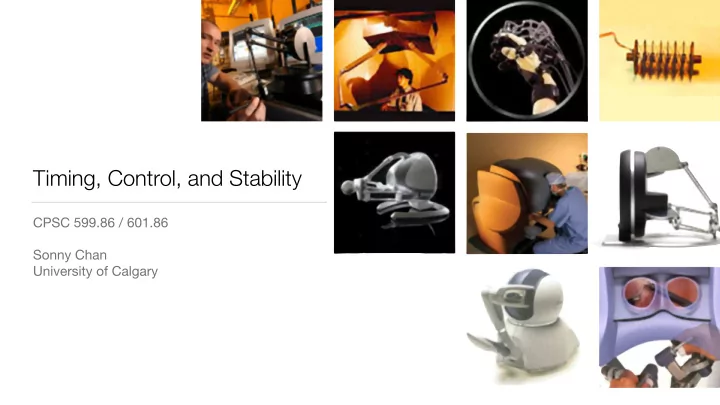

Timing, Control, and Stability CPSC 599.86 / 601.86 Sonny Chan University of Calgary
Today’s Topic: Timing is of the essence!
Visual-Haptic Simulation Simulation Visual rendering Simulation engine 24-60 Hz F d X S, X Haptic Collision Force Graphics Video device detection response engine F d ??? Hz How fast should we run the F r Control haptic rendering loop? algorithms Haptic rendering [From K. Salisbury et al., IEEE Computer Graphics & Applications 24(2), 2004.]
Haptic Rendering Loop • The faster, the better! x > 1000 Hz F
Motivation #1 – Perception • What’s the refresh rate of your computer monitor? - Why is it? 60 Hz • What’s the sampling rate of digital audio on a CD? - Why is it? 44100 Hz
Meissner corpuscle Merkel cell complex Mechanoreceptors in the Human Hand Ru ffi ni ending Pacinian corpuscle [From R. S. Johansson & A. B. Vallbo, Trends in Neurosciences 6, 1983.]
Receptor Feature Sensitivity Primary Functions Terminal • very low frequency vibration detection Sustained pressure, very low Merkel • coarse texture and pattern perception frequencies (<5 Hz) Temporal changes in skin Meissner • low frequency vibration detection deformation (5-40 Hz) • high frequency vibration detection Temporal changes in skin Pacinian • fine texture perception deformation (40-400 Hz) • direction of object motion due to skin stretch Sustained downward pressure, Ru ffi ni • finger position lateral skin stretch [Adapted from S. J. Lederman & R. L. Klatzky, Attention, Perception, & Psychophysics 71(7), 2009.]
Human Perception • Mechanoreceptors in our skin can detect vibrations up to ~400 Hz • We are generating a discrete force signal - sampling/playback rate should be above Nyquist frequency
Motivation #2 – Stability ADC x x • Haptic rendering on a digital computer is a closed-loop , discrete-time sampled system - digital-to-analog conversion - analog-to-digital conversion • Let’s examine some unique issues that can arise from such a system… DAC F F
Recall the Canonical Virtual Wall x ( if x > 0 − kx F ( x ) = 0 otherwise F
avatar force errors 0 0 0 0 5 5 5 5 10 10 10 10 15 15 15 15 Discrete-Time Sampled System position x ideal force F sampled position x F commanded force
avatar force errors 0 0 5 5 10 10 15 15 Effect of Stiffness k × 2 Errors get worse as stiffness is increased!
avatar faster sampling 0 0 5 5 10 10 15 15 Effect of Servo Rate Errors are reduced with an increased servo rate
Summary of Challenges • High stiffness and low servo rate can cause excess energy to be generated • Energy must be dissipated through mechanical device • Advanced control algorithms may help mitigate this problem
> 100 N/m 700 N/m > 1000 N/m On Sti ff ness… 3000 N/m > 10,000 N/m 5000 N/m > 100,000 N/m
Recommend
More recommend